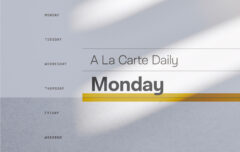Over the past few days I have been preparing to preach on Genesis 3, one of those amazing biblical texts that just opens wide as you begin to study it. One clear application from the first seven verses is that we need to know, believe and stand upon the Word of God. Adam and Eve did not do this–they doubted God’s Word. That doubt, that lack of trust, led to sin, led to the Fall, led to this world.
One thing I have been thinking about is the fact that Adam and Eve did not have God’s Word written for them. They had God’s Word spoken to them. And that brought me back to a study I did a few months ago on the ways in which humans have communicated over time. From the first days until today we have passed through various phases of communication, beginning with an oral culture, passing through a written and then printed culture, and now arriving at a digital culture.
I want to outline this flow over time and seek your input on a couple of things. So get reading and then help me out along the way.
Oral Culture
As far as we know, God created Adam and Eve not just with the ability to speak but with ability to speak meaningfully in some kind of a language. Created as adults, Adam and Eve were created with the ability to communicate with one another and with God. The speech they knew when they were created they taught to their children and their children after them. This was the first form of human communication. This was an oral culture in which words were not written but, rather, memorized and recited. What they did not remember or choose to record in their memories was lost forever.
It is difficult for those of us who live in the twenty-first century to imagine ourselves in an oral culture or to understand just how different our lives would be. Consider a world in which there existed no copy of the Words of God outside the memories of a small number of people. Many people would know snippets of these words, but only a small elite would know exhaustive words, exhaustive scriptures. When God told Adam and Eve not to eat of the tree of the Knowledge of Good and Evil, when he told them of the judgment that would fall upon them for their disobedience, these words were recorded only in the memories of those first humans. It was up to them to pass those words, faithfully and carefully, to their children. They could not reference chapter or verse; they could not even reference words carved in stone or written on paper. They could say only, “Here is what God has told us.” In those days there were words God spoke and words God didn’t speak, but there was no Scripture as we understand it today. Adam would teach Seth, “God said…” and that would be enough. Seth would tell his children who would tell their children. And so the words would pass from generation to generation.
Within such a culture, a culture with no access to writing, virtuous living was based less around an abstract set of values than it was based on interpersonal interaction. Philosophical thinking was largely dependent upon the written word and would be a later development. At this time, right living and wrong living was often defined by heroes and villains, and epic tales encouraged people to live like their heroes had lived. According to the Eerdmans Dictionary of the Bible, “Moral norms, trade skills, history, and every aspect of communal life were passed on in oral history.”
Within these cultures, a class of oral expert arose, a class of oral poets who would commit to memory vast histories and genealogies. Words were passed from one expert to the next with careful and deliberate memorization. We are amazed today as we learn of these feats of memory, but we are amazed only because such skills have been lost as memory has been outsourced first to paper and then to bit and bytes. Yet oral transmission in such cultures was very accurate in its own way. Oral poets would use formulaic expressions—figures of speech or groups of expressions, along with themes—groups of topics usually associated with one another, to build compositions. A poet telling a story might never tell it exactly the same way twice through hundreds of recitations, inserting different formulas in different orders, but the topics would remain much the same and the general content would change very little.
Writing
Though Adam and Eve could speak and remember, they could not write. Writing was a later development, one that came approximately 4,000 years before Christ. First came pictures, often depicting simple human activities such as hunting. Soon after that came pictures used to record historical events. Drawn on the walls of caves, for example, pictures began to take the place of oral transmission. Then came pictograms, pictorial representations for letters or sounds. Though there was at first typically some noticeable correlation between a pictogram and the object it presented so that the character for fish might be in the shape of a fish, scribes, drawing on damp clay using a pointed tool, soon found that it was easier to make a few simple marks rather than a drawing. As scribes communicated with one another, these markings became standardized across a culture. First an advance in economics, writing allowed records to be kept of land, harvests and loans. Pressed into soft clay and hardened in a kiln, marks would represent a commodity or a transaction. Syllabic writing soon developed, allowing each symbol to represent not a concept but a sound. The alphabet was not far behind, with evidence indicating some cultures may have turned to it as early as 2000 B.C.. Now each letter equaled a sound and words were composed of a string of letters put together, harmonizing reading and pronunciation.
As language developed, so too did the media upon which writing was placed. Stone was plentiful and long-lasting. But for the difficulty in inscribing upon it, it made an ideal medium as evidenced by God’s choice of stone as the media for his Ten Commandments. Many stone monuments carved thousands of years ago remain to this day. Clay was an easier medium to work with and offered a good compromise between ease-of-use, cost and durability. By the third millennium B.C. the Egyptians had discovered that they could make a paper-like medium from papyrus. Though not at all durable, it was convenient—easy and cheap to produce, simple to write upon and able to be joined together to form scrolls or codices. Parchment, made from the skins of animals, was the medium of choice for important and high-quality writing but it, too, was prone to decay. Paper was introduced from Asia to Egypt about 1000 years before Christ. Its heyday was to come in the age of print.
Oral culture did not immediately pass with the development of the written word. Even as B.C. turned to A.D., memory was still regarded as a pure and reliable means of transmission. Socrates, living some 450 years before Christ, regarded writing with suspicion, understanding rightly that writing would inevitably damage memory, as people stopped using their brains to remember but instead relied on the written word. He saw also that it would create a kind of false wisdom in which recollection, aided by written records, would overshadow true wisdom. We would be impressed not by understanding of facts, but instead by their mere accumulation (to quote Neal Postman). Many of Jesus’ words were recorded in memory and maintained there for years or decades before being written down by the chroniclers of his life, the writers of the gospels.
Even with the invention of writing, cultures remained largely oral. Literacy rates were very low and until the explosion of literacy following the invention of the printing press, far more people heard the Bible than read it. On the Sabbath day, one rabbi would read the Scriptures and everyone else would listen (and not with their own copy open in their laps). As they heard the words of God, they would immediately contextualize them, thinking about what came before and what came after. Thus as he announced the beginning of his ministry Jesus could quote from Isaiah and say, “Today this Scripture has been fulfilled in your hearing” (Luke 4:21) and the people would think not just of those words, but all they entailed. The early Christians could quote from the Bible saying only, “David said…” and the minds of the listeners would immediately understand the context. We may experience much the same thing today when we hear the words, “I have a dream.” We think not just of Martin Luther King, Jr., but of the national and racial context in which he gave that speech. Our minds immediately provide the context. We do not need chapter and verse but a simple pointer to the context (source).
Ideologies
Here is where I want your help. I want you to help me understand how a person’s worldview or how his ideologies would be shaped by being a product of an oral or written culture. Let me get the conversation started.
The mindset of those in an oral culture and written culture must have been very different from the mindset in our digital culture. There were different ideas bound up in orality and writing, different ideologies carried by it into the minds and worldviews of those immersed in it.
In an oral culture both recitation and interpretation were the realm of the expert. A scribe would write and a teacher or oral poet would read. The reading of Scripture was a community event, not one done in isolation. Interpretation was largely the same—a teacher would read the Scriptures and then explain it to those in attendance. So there would be little conception of a private or individual faith, little idea of a faith carried on by times of personal devotion. Faith was inherently a community activity. There is one great difference. In a print or digital culture we are far more isolated, far more prone to personal study and interpretation.
Second, when communicating orally, there is an immediate connection between the speaker and the listener. It is a very personal form of communication, it is an event that is experienced. The ancient Hebrews knew this and the word dabar carries a deeper meaning than the English word. We may think of a word as a collection of letters or symbols, something that is abstract and objective. But in the ancient Jewish mindset, a word conveyed some kind of a power, it was effective and effectual, making things happen. God spoke the world into existence through a word and promised that his word would never return to him empty (Isaiah 55:11). So there was a measure of subjectivity to words that became foreign in a later printed context.
Third, accuracy in an oral context is very different from within a print or digital context. In an oral culture a person spoke accurately if he properly conveyed the sense of a person’s words. Footnotes did not exist, quotation marks did not exist. Word-for-word accuracy was less important than thought-for-thought accuracy. So we see the writers of the gospels occasionally quoting Jesus’ words a little bit differently. In our minds we may see contradiction but in the oral mindset there was no contradiction at all as long as both authors accurately conveyed these sense of what Jesus had communicated.
With the ascendency of the written word it was inevitable that an oral culture would eventually give way. And indeed, it soon did just that. And as Socrates had predicted, memory soon faded as words became inscribed. I want to talk a bit about that tomorrow. But first help me see some of the other ways in which people of oral and printed culture were different from us.










